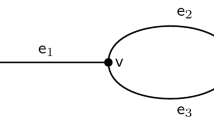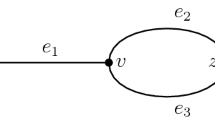Abstract
We prove interlacing inequalities between spectral minimal energies of metric graphs built on Dirichlet and standard Laplacian eigenvalues, as recently introduced in Kennedy et al. (Calc Var PDE 60:61, 2021). These inequalities, which involve the first Betti number and the number of degree one vertices of the graph, recall both interlacing and other inequalities for the Laplacian eigenvalues of the whole graph, as well as estimates on the difference between the number of nodal and Neumann domains of the whole graph eigenfunctions. To this end we study carefully the principle of cutting a graph, in particular quantifying the size of a cut as a perturbation of the original graph via the notion of its rank. As a corollary we obtain an inequality between these energies and the actual Dirichlet and standard Laplacian eigenvalues, valid for all compact graphs, which complements a version for tree graphs of Friedlander’s inequalities between Dirichlet and Neumann eigenvalues of a domain. In some cases this results in better Laplacian eigenvalue estimates than those obtained previously via more direct methods.








Similar content being viewed by others
Notes
Here we will be considering fewer classes of partitions, and fewer types of spectral energy, than in [21]; we will thus adopt simpler notation. In the language and notation of [21] we are interested in the most general case of connected partitions, not necessarily exhaustive, and the case \(p=\infty \). See “Appendix A” for more details.
Thus, for us, a metric graph is what is usually called a compact metric graph in the literature.
Note, however, that Neumann vertex conditions (not to be confused with Neumann–Kirchhoff) are different from standard ones; the former do not require continuity at the vertex, while at the vertex every derivative on every edge needs to be zero.
As mentioned in the introduction, here and below our notation is slightly different from that in [21], as here the subscript gives the number of clusters k rather than the value of p in the p-norm of the combination of eigenvalues. The reason is that here it will be important to keep track of the number of clusters of our partitions, whereas we always consider functionals built via the \(\infty \)-norm of the vector of eigenvalues. We are also suppressing a superscript; see “Appendix A.”
References
Alon, L., Band, R.: Neumann domains on quantum graphs, preprint (2019). arXiv:1911.12435
Alon, L., Band, R., Berkolaiko, G.: Nodal statistics on quantum graphs, Commun. Math. Phys. 362 (362), 909–948 (2018)
Alon, L., Band, R., Bersudsky, M., Egger, S.: Neumann domains on graphs and manifolds, Chapter 10 in M. Keller, D. Lenz and R. K. Wojciechowski (eds.), Analysis and Geometry on Graphs and Manifolds, London Math. Soc. Lecture Note Ser., vol. 461, Cambridge University Press, Cambridge (2020)
Arendt, W., Mazzeo, R.: Friedlander’s eigenvalue inequalities and the Dirichlet-to-Neumann semigroup. Commun. Pure Appl. Anal. 11, 2201–2212 (2012)
Ariturk, S.: Eigenvalue estimates on quantum graphs, preprint (2016). arXiv:1609.07471
Band, R., Berkolaiko, G., Raz, H., Smilansky, U.: The number of nodal domains on quantum graphs as a stability index of graph partitions. Commun. Math. Phys. 311, 815–838 (2012)
Band, R., Berkolaiko, G., Weyand, T.: Anomalous nodal count and singularities in the dispersion relation of honeycomb graphs. J. Math. Phys. 56, 122111 (2015)
Band, R., Lévy, G.: Quantum graphs which optimize the spectral gap. Ann. Henri Poincaré 18, 3269–3323 (2017)
Berkolaiko, G.: A lower bound for nodal count on discrete and metric graphs. Commun. Math. Phys. 278, 803–819 (2008)
Berkolaiko, G., Kennedy, J.B., Kurasov, P., Mugnolo, D.: Edge connectivity and the spectral gap of combinatorial and quantum graphs. J. Phys. A: Math. Theor. 50, 365201 (2017)
Berkolaiko, G., Kennedy, J.B., Kurasov, P., Mugnolo, D.: Surgery principles for the spectral analysis of quantum graphs. Trans. Am. Math. Soc. 372, 5153–5197 (2019)
Berkolaiko, G., Kuchment, P.: Introduction to Quantum Graphs, Mathematical Surveys and Monographs, vol. 186. American Mathematical Society, Providence, RI (2013)
Bogosel, B., Bonnaillie-Noël, V.: Minimal partitions for \(p\)-norms of eigenvalues. Interfaces Free Bound. 20, 129–163 (2018)
Bonnaillie-Noël, V., Helffer, B.: Nodal and spectral minimal partitions - The state of the art in 2016, Chapter 10. In: Henrot, A. (ed.) Shape Optimization and Spectral Theory. De Gruyter Open, Warsaw (2017)
Bonaillie-Noël, V., Léna, C.: Spectral minimal partitions for a family of tori. Exp. Math. 26, 381–395 (2017)
Conti, M., Terracini, S., Verzini, G.: On a class of optimal partition problems related to the Fučík spectrum and to the monotonicity formulae. Calc. Var. Partial Differ. Equ. 22, 45–72 (2005)
Helffer, B., Hoffmann-Ostenhof, T., Terracini, S.: Nodal domains and spectral minimal partitions. Ann. Inst. Henri Poincaré (C) Anal. Non Lineaire 26, 101–138 (2009)
Hofmann, M., Kennedy, J.B., Mugnolo, D., Plümer, M.: Asymptotics and estimates for spectral minimal partitions of metric graphs. Int. Equ. Oper. Theory 93, 26 (2021)
Filonov, N.: On an inequality for the eigenvalues of the Dirichlet and Neumann problems for the Laplace operator. St. Petersburg Math. J. 16, 413–416 (2005)
Friedlander, L.: Some Inequalities between Dirichlet and Neumann Eigenvalues. Arch. Rat. Mech. Anal. 116, 153–160 (1991)
Kennedy, J.B., Kurasov, P., Léna, C., Mugnolo, D.: A theory of spectral partitions of metric graphs. Calc. Var. Partial Differ. Equ. 60, 61 (2021)
Kennedy, J.B., Kurasov, P., Malenová, G., Mugnolo, D.: On the spectral gap of a quantum graph. Ann. Henri Poincaré 17, 2439–2473 (2016)
Kurasov, P., Serio, A.: On the sharpness of spectral estimates for graph Laplacians. Rep. Math. Phys. 82, 63–80 (2018)
Mugnolo, D.: What is actually a metric graph?, preprint (2019). arXiv:1912.07549
Nicaise, S.: Spectre des réseaux topologiques finis. Bull. Sci. Math. (2) 111, 401–413 (1987)
Rohleder, J.: Eigenvalue Estimates for the Laplacian on a Metric Tree. Proc. Am. Math. Soc. 145, 2119–2129 (2017)
Serio, A.: On extremal eigenvalues of the graph Laplacian. J. Phys. A: Math. Theor. 54, 0152020 (2021)
Author information
Authors and Affiliations
Corresponding author
Additional information
Publisher's Note
Springer Nature remains neutral with regard to jurisdictional claims in published maps and institutional affiliations.
The authors wish to thank Gregory Berkolaiko and Delio Mugnolo for their thoughtful and helpful comments on an earlier version of this paper, and Andrea Serio and the anonymous referee for many useful suggestions on an intermediate version of it. Both authors were supported by the Fundação para a Ciência e a Tecnologia, Portugal, via the project NoDES: Nonlinear Dispersive and Elliptic Systems, reference PTDC/MAT-PUR/1788/2020 (J.B.K.), and the programs “Investigador FCT”, reference IF/01461/2015 (J.B.K.) and “Bolseiro de Investigação”, reference PD/BD/128412/2017 (M.H.). The work of both authors was also partially supported by the COST Association (Action CA18232)
Appendix A. Rigid partitions
Appendix A. Rigid partitions
In the current work we always considered general (“connected”) partitions of graphs, where cuts could be made anywhere, including in the middle of the partition elements (the clusters). This was natural for the theory developed: when creating partitions by cutting along eigenfunctions, as was central to the proofs of Theorems 1.1 and 1.2, a priori one has no control over where one is cutting.
On the other hand, inspired by the situation on domains, a second, more restricted class of partitions was also introduced in [21], where the graph can only be cut at the boundary of the partition clusters and not in their interior. This corresponds to the idea that when partitioning a domain \(\Omega \) into pieces \(\Omega _i\), there should be no “extra” incisions made in the interior of the \(\Omega _i\); that is, \(\partial \Omega _i\) should correspond exactly to where \(\Omega _i\) meets the other \(\Omega _j\). This second class may be defined as follows.
Definition A.1
We say a (connected) k-partition \({\mathcal {P}}=({\mathcal {G}}_1, \ldots , {\mathcal {G}}_k)\) of \({\mathcal {G}}\) is rigid if its boundary set \(\partial {\mathcal {P}}\) (see Definition 2.12) coincides with the cut set \({\mathcal {C}}({\mathcal {G}}_{\mathcal {P}}:{\mathcal {G}})\) (see Definition 2.1). We denote the set of all exhaustive rigid k-partitions of \({\mathcal {G}}\) by \({\mathfrak {R}}_k = {\mathfrak {R}}_k ({\mathcal {G}})\).
An example of a non-rigid 4-partition (right) of the graph from Fig. 1 (a) (reproduced here, left). The partition is not rigid due to the additional cut in the middle of the loop
The corresponding minimization problems were denoted as follows in [21, Section 4]:
and
Thus our \({{{\mathcal {L}}}^{N}_{k} ({\mathcal {G}})}\) equals \({\mathcal {L}}^{N,c}_{k,\infty }({\mathcal {G}})\) in [21]. Clearly \({\mathfrak {R}}_k \subset {\mathfrak {C}}_k\), whence \({\mathcal {L}}^{N,r}_{k,p}({\mathcal {G}}) \ge {\mathcal {L}}^{N,c}_{k,p}({\mathcal {G}})\) always (in the Dirichlet case, minimizing over \({\mathfrak {R}}_k\) or \({\mathfrak {C}}_k\) makes no difference [21, Lemma 4.3], justifying the common notation \({\mathcal {L}}^D_{k,p}({\mathcal {G}})\)).
We briefly summarize how our Theorems 1.1 and 1.2 can be adapted to rigid partitions: as noted, since \({{\mathcal {L}}^{N,r}_{k,\infty }({\mathcal {G}}) \ge {{\mathcal {L}}}^{N}_{k} ({\mathcal {G}})}\), Theorem 1.1 can be obtained for free:
for all \(k \ge \max \{\beta ,1\}\). It is not at all clear whether Theorem 1.2 should hold in the rigid case; here, we merely observe that it will hold for k large enough since, by [18, Theorem 3.3], \({{\mathcal {L}}^{N,r}_{k,\infty }({\mathcal {G}}) = {{\mathcal {L}}}^{N}_{k} ({\mathcal {G}})}\) for sufficiently large \(k \ge 1\) (how large depending on the graph): there exists some \(k_0 = k_0 ({\mathcal {G}}) \ge \beta + |{\mathcal {V}}^1|\) such that
for all \(k \ge k_0\). In principle it would be possible to estimate \(k_0\) explicitly in terms of explicit features of the graph, but we expect the effort necessary to do so would be disproportionate to its value.
Rights and permissions
About this article
Cite this article
Hofmann, M., Kennedy, J.B. Interlacing and Friedlander-type inequalities for spectral minimal partitions of metric graphs. Lett Math Phys 111, 96 (2021). https://doi.org/10.1007/s11005-021-01438-6
Received:
Revised:
Accepted:
Published:
DOI: https://doi.org/10.1007/s11005-021-01438-6





